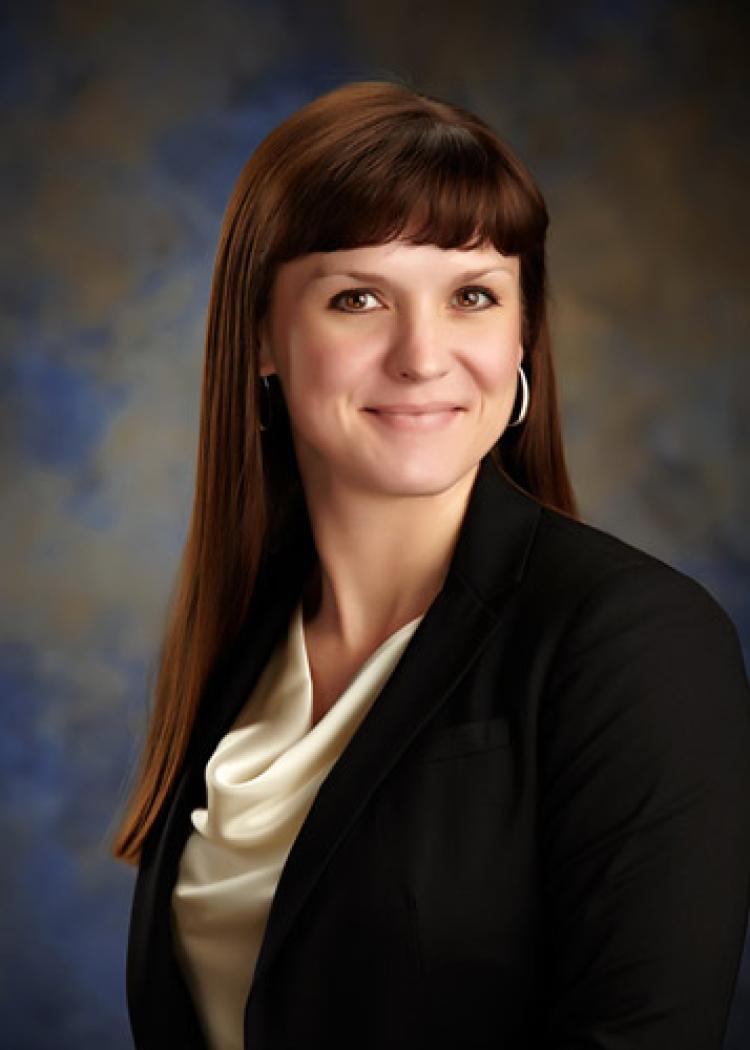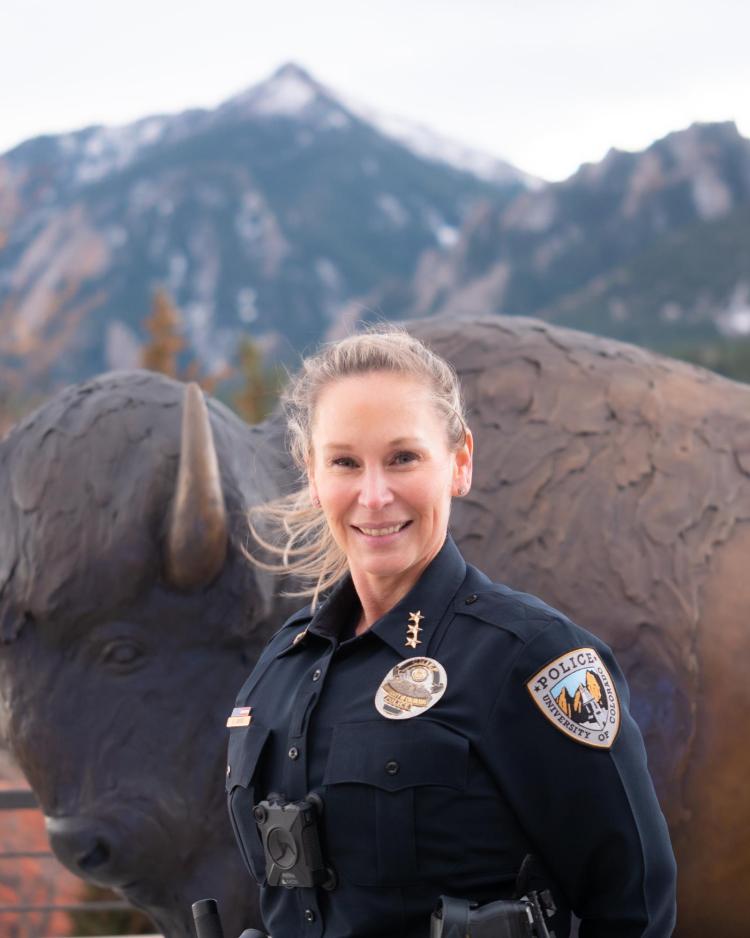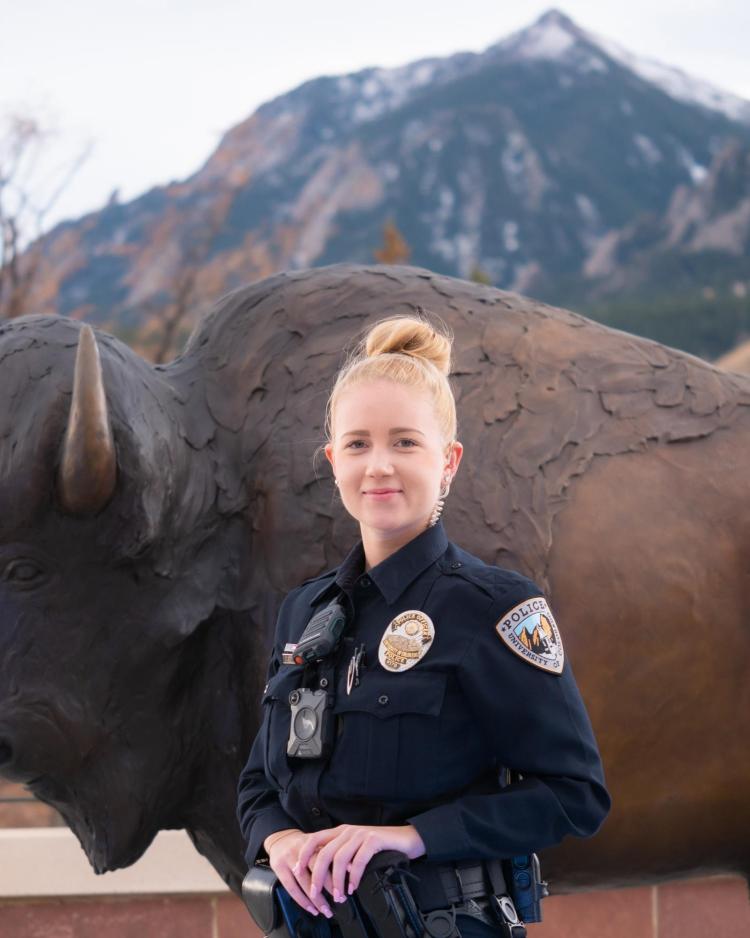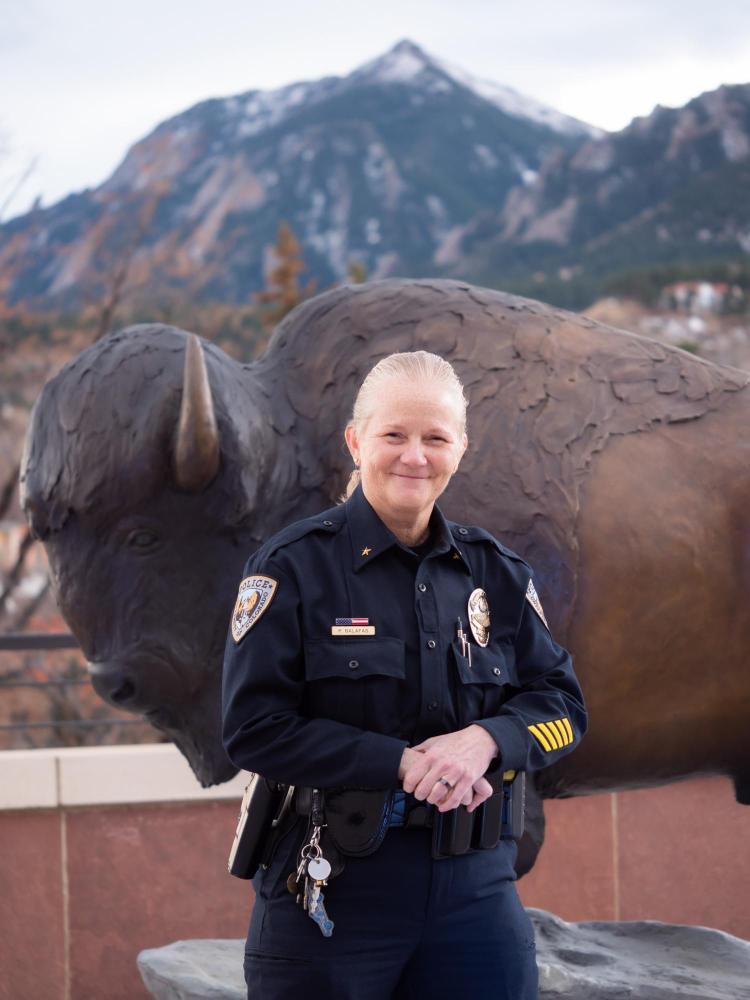Above national average for hiring female officers, CUPD looks to go further
Image caption: CUPD Chief Doreen Jokerst is joined by a group of women CUPD police officers on the terrace of the Center for Academic Success and Engagement (CASE) building. Pictured left to right are Officer Jennifer Aycock; Sergeant Mary Vekasy; Officer Dorie Schram; Chief Jokerst; Commander Paula Balafas; Officer Cassandra Yuma; Officer Sara Fraser; and Officer Michelle Leo (CU photo by Glenn Asakawa)
Editor’s note: This story is the second in a series about the CU Police Department’s ongoing efforts to increase transparency, accountability and trust with the campus community. Read the first article here.
University of Colorado Boulder Police Chief Doreen Jokerst has worked in nearly every capacity as a police officer over the past two decades––investigations, professional conduct, crime scene management and patrolling––working her way through the ranks in her field.
And yet, when Jokerst and her husband, a homicide detective for a Denver-area police department, stroll through conference exhibition halls in civilian clothing, vendors inevitably bypass her and attempt to pitch products and services to her husband. When that happens, her husband nods toward his wife and says matter-of-factly, “You should ask her––she’s the chief.”
Interactions like this might seem inconsequential, but assumptions about what a law enforcement officer does or doesn’t look like based on gender, race, ethnicity, LGBTQ+ status, religion, national origin or another personal identifier make it more difficult to shift the profession’s internal culture at a time when communities across the country are clamoring for reform, experts say.
As it turns out, building a more diverse corps of officers in law enforcement can lead to fewer traffic stops, fewer arrests and less use of force, especially within communities of color, according to a recent study, whose initial findings were published in the journal Science. Based on an analysis of records of millions of daily patrol assignments, the study’s authors conclude “diversity reforms can improve police treatment” of citizens in communities of color.
Kimberly Miller, a Colorado-based psychologist who specializes in organizational change in law enforcement, works with CUPD and other agencies around the country on how they can implement more diverse, equitable and inclusive practices among their ranks so they can better serve the communities they are sworn to serve and protect.

Police psychologist and consultant Kimberly Miller
Among her tips to law enforcement agencies: Create targeted strategies for recruiting women and people of color to send the clear message they are welcome and their perspectives and life experiences are needed and wanted. Women leaders, in particular, can play a critical role in effecting change within agencies mired in policies and employment strategies that no longer work.
“If you want to change the culture of a police department, it starts with hiring more women and putting them in positions throughout the different components of a police department,” Miller says.
Supporting women in policing
Based on two decades of her own experience in the field, Jokerst believes women bring perspectives that can bring about positive change in law enforcement agencies, whether it be in a small campus police department like CUPD or in a larger city agency.
Only 14 years old when the Parker Police Department accepted her into its cadet program, she went on to earn a bachelor’s degree in criminal justice and a master’s degree in psychology. The only sworn officer in her family, she now leads a university police department with 43 commissioned officers and 60 staff members who serve a community of 35,000 students and 9,000 employees on the flagship campus of Colorado’s leading public research university.
Admittedly, campus police departments are unique in that officers are required to safeguard the well-being of a unique and particular set of constituents: thousands of students, faculty, staff, and campus visitors who trek to CU Boulder every year. Another aspect of their roles is to protect university property and to educate the public about campus policies and local, state and federal laws.

Chief Doreen Jokerst
One of those federal laws is the Clery Act, which requires universities to report campus crime in a timely manner and with a high degree of accountability and transparency. To comply with the law, universities must compile a yearly security and fire safety report, Jokerst says.
“Universities have crime––anything from vandalism to violence,” the CUPD chief says. “In addition, at any given time there are thousands of people on campus. It is our job to create a safe environment for our community members to learn and work in and for those who visit our beautiful campus.”
Under Jokerst’s watch, CUPD has surpassed the national average for recruiting and hiring female police officers, and the department’s most recent recruitment plan includes goals for hiring more women and more officers of color over the next three years.
Recently, as a demonstration of its commitment to diversify its ranks, CUPD signed the 30x30 Initiative, a national pledge to improve the representation of and experiences of women working in public safety and law enforcement.
Currently, CUPD has eight commissioned female officers among its ranks, comprising about 17% of its total corps––which is above the national average of 12% for the typical police department. Since taking the helm of CUPD, Jokerst has hired three new female officers.
In addition to her commitment to hire more female officers, Jokerst has set a goal to double the number of diverse officers in her department.
“More diverse organizations are likely to increase employees’ job satisfaction and commitment to their agency,” Jokerst says. “They also make for more inclusive work environments and an appreciation of individual differences. It also leads to better decision-making that benefits our community.”
Rookie officer returns home to Boulder
CUPD officers include both veterans and newcomers who want to make a difference while they develop their careers in higher education, including Boulder native Dorie Schram.
Schram, 24, who returned to her hometown after graduating from the College of Wooster in Ohio with a bachelor’s degree in psychology, has aspired to work in policing since she was a little girl, and campus police work seemed like a good fit for her first professional job, she says.

Officer Dorie Schram
In Ohio, she engaged in restorative justice work by helping to rehabilitate prisoners. After returning to Boulder, she applied for a CUPD job and underwent six months of rigorous police academy training followed by 15 weeks of on-the-job training. Schram feels strongly there is a lot of good that can be done in public safety and law enforcement and, “I want to be a part of that,” Schram says.
She agrees female officers tend to get “sized up” based on gender. However, though law enforcement remains a male-dominated field, she agrees women and individuals from diverse backgrounds can bring unique perspectives to the job that can help turn the tide toward more inclusive policing practices and policies.
“Women can embody that unique perspective,” she says. “This can be seen through the way we interact with the things we are presented with and in the way we relate to people.”
Regardless of gender, she adds, good communication is key to serving the public: “Being honest and respectful to people goes a long way in terms of getting cooperation, especially among groups of people such as our unhoused population or people who have had a history with the criminal justice system, as they aren’t always given that respect.”
Veteran officer ‘landed where I was supposed to be’
CUPD Commander Paula Balafas, who presides as president of the National Association of Women Law Enforcement Executives or NAWLEE, has served in law enforcement roles for the past 31 years, including tenures with the Denver Sheriff’s Department and the Wheat Ridge and Cherry Hills police departments.
Balafas started her career as a police officer after graduating from CU Boulder with bachelor’s degree in English literature and later earned a master’s degree in the same field of study. Shifting the culture of policing by hiring more women and officers of color is critical for any police department, she says.
“You really want your police force to resemble or represent the community in which it serves. More than anything else you want to have that immediate connection with your population,” Balafas says. “By hiring a diverse workforce, then you are also showing that you are willing to change.”

Sergeant Paula Balafas
Networking with fellow women officers can be instrumental to helping women succeed in public safety and police work, Balafas says. After attending her first national police conference two decades ago, she was promoted to sergeant within six months, performing well throughout the competitive process due, in part, to the tips she received from other women officers.
Years later, when she got the opportunity to join CUPD, she “landed where I was supposed to be,” and now works in an academic environment that energizes her.
“I’m sure a lot of students don’t see the police as any sort of ally, but that’s kind of what we signed up for,” Balafas says. “We want to make a difference on campus. We want a safe campus, and we want students to feel like we are here for them.”
Chief Jokerst, who meets frequently with campus constituents in person or via Zoom sessions, says she wants to address community concerns about police work in general and demonstrate that she and her officers are committed to serving and protecting the campus community in progressive ways.
“National implications in police work have local impacts and cause distrust between the community and law enforcement,” she acknowledges. “It is my job to continue to build bridges with the community I humbly serve and to ensure they know CUPD is their police department. We are better together, and I will continue to work with our community and to hear their voices.”


